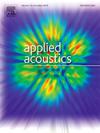Sustainable Grewia Optiva–Bio-Resin composites for broadband acoustic absorption
IF 3.4
2区 物理与天体物理
Q1 ACOUSTICS
引用次数: 0
Abstract
This study investigates sustainable sound-absorbing composites developed from Grewia Optiva fibers (GOF) and hybrid resin systems composed of epoxy and natural gums—pine, Lannea Coromandelica, dhawda, and babool. Composites with 5–40 wt% GOF were fabricated and tested for acoustic absorption using the impedance tube method (ASTM E1050-12) across 150–5000 Hz. Results showed enhanced sound absorption, with the epoxy–pine composite achieving a peak sound absorption coefficient (SAC) of 0.83 at 4500 Hz. Morphological analysis revealed GOF’s high porosity and hollow lumen structure as key to broadband damping. Mechanical tests confirmed sufficient tensile (47.2 MPa) and flexural strength (99.7 MPa) for structural applications. Genetic algorithm (GA) optimization identified 24.99 wt% fiber and 20 wt% gum as the optimal configuration for balancing acoustic and mechanical performance. Compared to conventional and other natural fiber composites, GOF-based systems demonstrated superior SAC across all frequency bands. These bio-composites show strong potential for application in automotive interiors, architectural panels, and marine noise insulation, offering an eco-friendly and high-performance alternative to synthetic materials.
可持续的Grewia Optiva-Bio-Resin复合材料用于宽带声吸收
本研究研究了由Grewia Optiva纤维(GOF)和由环氧树脂和天然松木、Lannea Coromandelica、dhawda和babool组成的混合树脂体系开发的可持续吸声复合材料。制作5-40 wt% GOF的复合材料,并使用阻抗管法(ASTM E1050-12)在150-5000 Hz范围内测试声吸收。结果表明,环氧松木复合材料在4500 Hz时吸声系数达到0.83;形态学分析表明,高孔隙率和中空腔结构是宽带阻尼的关键。机械测试证实结构应用具有足够的拉伸(47.2 MPa)和弯曲强度(99.7 MPa)。遗传算法(GA)优化确定24.99 wt%纤维和20 wt%胶为平衡声学和力学性能的最佳配置。与传统和其他天然纤维复合材料相比,基于gof的系统在所有频段都表现出优越的SAC。这些生物复合材料在汽车内饰、建筑面板和船舶隔音方面显示出强大的应用潜力,为合成材料提供了环保和高性能的替代品。
本文章由计算机程序翻译,如有差异,请以英文原文为准。
求助全文
约1分钟内获得全文
求助全文
来源期刊

Applied Acoustics
物理-声学
CiteScore
7.40
自引率
11.80%
发文量
618
审稿时长
7.5 months
期刊介绍:
Since its launch in 1968, Applied Acoustics has been publishing high quality research papers providing state-of-the-art coverage of research findings for engineers and scientists involved in applications of acoustics in the widest sense.
Applied Acoustics looks not only at recent developments in the understanding of acoustics but also at ways of exploiting that understanding. The Journal aims to encourage the exchange of practical experience through publication and in so doing creates a fund of technological information that can be used for solving related problems. The presentation of information in graphical or tabular form is especially encouraged. If a report of a mathematical development is a necessary part of a paper it is important to ensure that it is there only as an integral part of a practical solution to a problem and is supported by data. Applied Acoustics encourages the exchange of practical experience in the following ways: • Complete Papers • Short Technical Notes • Review Articles; and thereby provides a wealth of technological information that can be used to solve related problems.
Manuscripts that address all fields of applications of acoustics ranging from medicine and NDT to the environment and buildings are welcome.
 求助内容:
求助内容: 应助结果提醒方式:
应助结果提醒方式:


